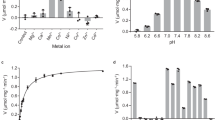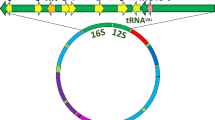Abstract
IN mammals, lactic dehydrogenase (LDH) has five molecular forms which show species and tissue specific patterns by starch-gel electrophoresis1. These molecular forms appear to be tetramers of two different polypeptide sub-units in their five possible combinations2,3. The two types of sub-units have been termed ‘A’ and ‘B’ (ref. 2), or ‘M’ and ‘H’ referring to their predominance in skeletal muscle and heart respectively3. The M(uscle) type of lactic dehydrogenase is best suited for anaerobic metabolism and the H(eart) type is best suited for oxidative metabolism3,4. Since glycolysis or anaerobic metabolism is phylogenetically more ancient that aerobic metabolism5, a shift in certain tissues from M LDH to H LDH would be expected during the phylogenetic development of higher animals. From a comparative study of lactic dehydrogenases in a small series of vertebrate brains, Bonavita and Guarneri6 provided evidence that this trend occurred during the emergence of warm-blooded vertebrates. The present communication provides evidence that such a shift was still occurring during the evolution of the order Primates.
This is a preview of subscription content, access via your institution
Access options
Subscribe to this journal
Receive 51 print issues and online access
$199.00 per year
only $3.90 per issue
Buy this article
- Purchase on Springer Link
- Instant access to full article PDF
Prices may be subject to local taxes which are calculated during checkout
Similar content being viewed by others
References
Markert, C. L., and Møller, F., Proc. U.S. Nat. Acad. Sci., 45, 753 (1959).
Apella, E., and Markert, C. L., Biochem. Biophys. Res. Comm., 6, 171 (1961).
Cahn, R. D., Kaplan, N. O., Levine, L., and Zwilling, E., Science, 136, 962 (1962).
Dawson, D. M., Goodfriend, T. L., and Kaplan, N. O., Science, 143, 929 (1964).
Oparin, A. I., The Origin of Life on the Earth, 419 (Academic Press New York, 1957).
Bonavita, V., and Guarneri, R., J. Neurochem., 10, 742 (1963).
Fiedler, W., in Primatologia, edit. by Hofer, H., et al., 1, 1 (Karger, Basle. 1956).
Smithies, O., Biochem. J., 71, 585 (1959).
Boyer, S. H., Fainer, D. C., and Naughton, M. A., Science, 140, 1228 (1963).
Straus, jun, W. L., Quart. Rev. Biol., 24, 200 (1949).
Edinger, T., Amer. Zoo., 4, 5 (1964).
Author information
Authors and Affiliations
Rights and permissions
About this article
Cite this article
SYNER, F., GOODMAN, M. Differences in the Lactic Dehydrogenases of Primate Brains. Nature 209, 426–428 (1966). https://doi.org/10.1038/209426a0
Issue Date:
DOI: https://doi.org/10.1038/209426a0
This article is cited by
-
Aerobic glycolysis in the primate brain: reconsidering the implications for growth and maintenance
Brain Structure and Function (2014)
-
Human uniqueness: genome interactions with environment, behaviour and culture
Nature Reviews Genetics (2008)
-
An apparent progressive and recurrent evolutionary restriction in tissue expression of a gene, the lactate dehydrogenase-C gene, within a family of bony fish (Salmoniformes: Umbridae)
Journal of Molecular Evolution (1986)
-
Lactate dehydrogenase isozymes: Qualitative and quantitative changes during primate evolution
Biochemical Genetics (1969)
-
Evidence for the Random Aggregation of Sub-units to produce Multiple Forms of Lactate Dehydrogenase in the Brains of Rat and Man
Nature (1967)
Comments
By submitting a comment you agree to abide by our Terms and Community Guidelines. If you find something abusive or that does not comply with our terms or guidelines please flag it as inappropriate.



